Tags
Leafing through Volume 1 of the Seiko watch catalogue from 1976*, one is struck by how much the quartz revolution had taken its grip on the market at the time. The opening pages are dedicated to high-end quartz Seiko’s priced at extraordinary levels.
 You might imagine after this opening salvo of ostentation, that the catalogue would segue into the upper reaches of the mechanical range but instead we get two pages of those new-fangled LCD digital watches.
You might imagine after this opening salvo of ostentation, that the catalogue would segue into the upper reaches of the mechanical range but instead we get two pages of those new-fangled LCD digital watches.
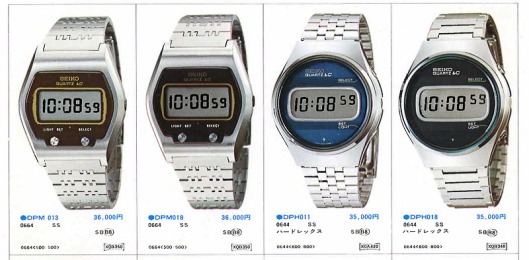 Page 8 introduces the Grand Quartz range fitted with 4840 series quartz movements
Page 8 introduces the Grand Quartz range fitted with 4840 series quartz movements
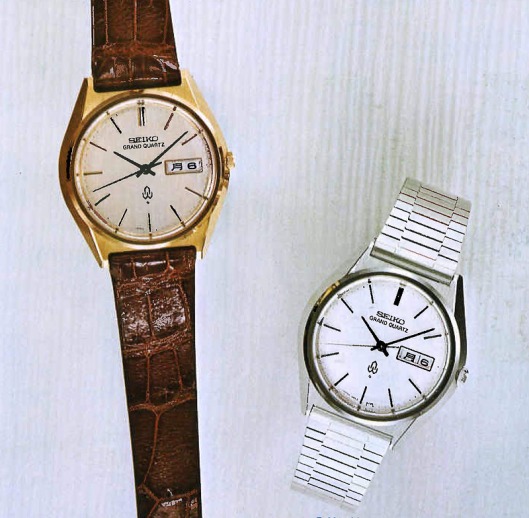 and on p.10, the 4820 series of King Quartzes kick in, one level down from the Grand Quartz. In the bottom right hand corner of p.11, we meet model number QNE011, a very handsome smoky blue-dialed King Quartz fitted with a nice black crocodile strap and priced at a bargain 51,000 Yen (£76/$170).
and on p.10, the 4820 series of King Quartzes kick in, one level down from the Grand Quartz. In the bottom right hand corner of p.11, we meet model number QNE011, a very handsome smoky blue-dialed King Quartz fitted with a nice black crocodile strap and priced at a bargain 51,000 Yen (£76/$170).
 A Rolex Datejust 1603 from the same period would have cost in the region of £160 so these early higher-end quartz watches were not quite the budget proposition one might have imagined from the perspective of 2015.
A Rolex Datejust 1603 from the same period would have cost in the region of £160 so these early higher-end quartz watches were not quite the budget proposition one might have imagined from the perspective of 2015.
Page after page of rather uninspiring stuff follows until eventually on p.34 we come across the first mechanical watches. It is particularly striking that the 6105-8110 divers watch featured on p.45, fitted with the iconic 731 rubber strap, is priced at considerably less than half the price of the King Quartz that caught my eye on p.11. How the tables have turned since.
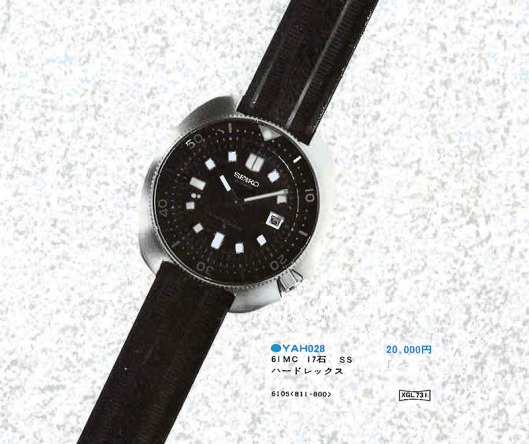 A few weeks ago, I happened upon an auction for a Seiko King Quartz 4822-8000 from November 1975 (model QNE011 from that 1976 catalogue).
A few weeks ago, I happened upon an auction for a Seiko King Quartz 4822-8000 from November 1975 (model QNE011 from that 1976 catalogue).
I gave it a second glance for no better reason than that I rather liked the cut of its jib. The translation of the description reported that ‘because of battery exhaustion, it is not possible to confirm operation. Please note that we cannot offer compensation in the event of failure.’ This seems to have put off some of my competition and in the end I secured what I felt at the time could be a bit of a bargain, particularly as the watch as pictured appeared to be fitted with its original strap to which the original price tag was still attached.
Information on the 48 series movements is a bit thin on the ground but from what I can gather they were introduced in 1975 and were a development on the 38series of high quality quartz movement, the first Seiko quartz movement to be produced in large quantities. That earlier movement featured a 16382 Hz quartz oscillator but the 48series doubled that to 32768 Hz. I am not at all clear to what extent the 4840 series fitted to the Grand Quartz’s distinguishes itself from the 4820 series but both movements, with 7 jewels, trimmer condensers and a high level of finishing certainly look several cuts above the disposable mass produced quartz movements fitted to many modern quartz watches. When I received my watch, it was clear that it was essentially un-used stock. The rear of the strap had perished
but the case was largely unmarked and the dial, hands, crystal all looked to be in pristine original condition. I had no great urge to do anything much in the way of work to this one unless the replacement battery failed to spark it back into life. The battery is easily accessed on these watches via a bayonet hatch, sealed against water ingress using a flat rubber gasket. A quarter turn anti-clockwise and the old Maxwell SR43SW popped out, and a check on my multimeter confirmed it to be exhausted. 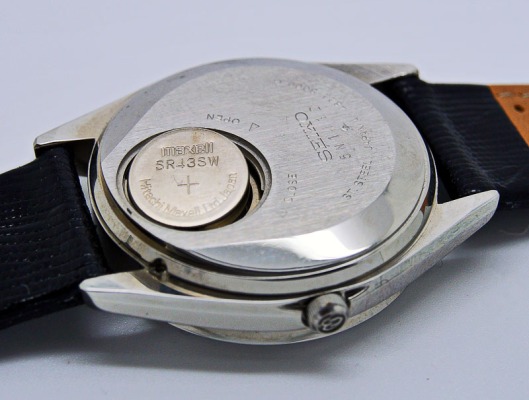 A quick test with a fresh battery, and the watch resumes service, unperturbed by the 40-odd year interval since it last saw action. Having had a glimpse at the innards through the porthole battery hatch, I couldn’t resist a closer look and so out with my case back knife and off comes the snap back case back:
A quick test with a fresh battery, and the watch resumes service, unperturbed by the 40-odd year interval since it last saw action. Having had a glimpse at the innards through the porthole battery hatch, I couldn’t resist a closer look and so out with my case back knife and off comes the snap back case back:
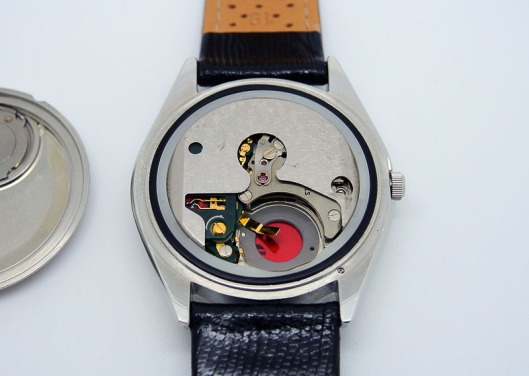 Most of the movement at this point is obscured by the integrated movement cover/spacer but this can be removed by gently prising it away, having first removed the caseback gasket.
Most of the movement at this point is obscured by the integrated movement cover/spacer but this can be removed by gently prising it away, having first removed the caseback gasket.
 As quartz movements go, this one has a pretty sleek modern look, handsome even, with a definite air of quality. You can see from the finishing to the train wheel bridge that in the midst of this pioneering brave new world of quartz technology, Seiko were taking a certain degree of pride in justifying the not insignificant asking price.
As quartz movements go, this one has a pretty sleek modern look, handsome even, with a definite air of quality. You can see from the finishing to the train wheel bridge that in the midst of this pioneering brave new world of quartz technology, Seiko were taking a certain degree of pride in justifying the not insignificant asking price.
Having reassembled the case back parts and refitted the new battery, I was rather startled to see the seconds hand leap forward 10 seconds to the 12 mark when I pulled out the crown to the time-setting position. Rather than this being some sort of fault, it is in fact a feature, there to aid in the rapid synchronization of time when resetting the watch.
You can see in the photos above that I’d already replaced the original strap with a rather shiny Di Modell lizard strap that I think suits it rather well. The watch is ready to wear now and on the wrist I have to say it has a certain je ne sais quoi. In fact I think I do know what the ‘quoi’ is. It’s that dial, combined with the blue anti-reflective coating on the flat crystal. From some angles, it’s the AR coating that dominates proceedings:
 A slight change of angle, and we see a hint of the true dial colour beneath:
A slight change of angle, and we see a hint of the true dial colour beneath:
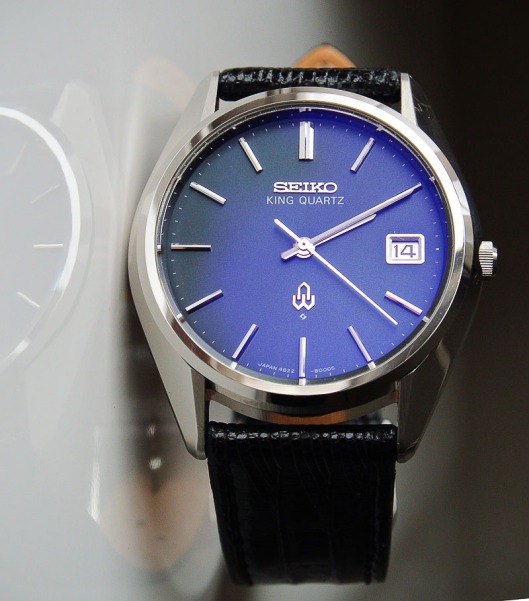 and shift position again, and the view of the smoky dial is very nearly completely unhindered, the crystal almost having vanished from view:
and shift position again, and the view of the smoky dial is very nearly completely unhindered, the crystal almost having vanished from view:
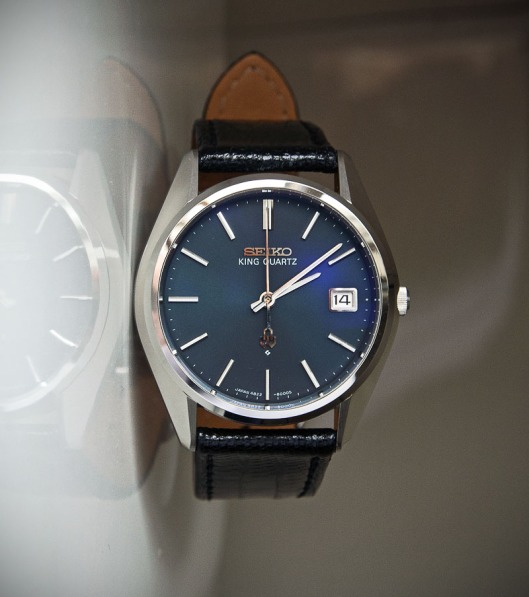 There is more to appreciate too in the case, reminiscent of the ‘Grammar of Design’ motif used in the Grand Seiko’s produced from the late 1960’s to mid-70’s. I like in particular the view from the crown side:
There is more to appreciate too in the case, reminiscent of the ‘Grammar of Design’ motif used in the Grand Seiko’s produced from the late 1960’s to mid-70’s. I like in particular the view from the crown side:
 where we see the bowl-shaped sweep of the case and lugs encapsulating and partially hiding the bezel at the points where the lugs start their descent to the watch strap. It is somehow heartening to see so much care going into the design of a watch that is destined to make a brief appearance somewhere in the midst of a 100 page watch catalogue from the mid-70’s. Three more to finish, each of which providing a slightly different take on how the watch appears when viewed at angles that that inhibit the show-off tendencies of the crystal:
where we see the bowl-shaped sweep of the case and lugs encapsulating and partially hiding the bezel at the points where the lugs start their descent to the watch strap. It is somehow heartening to see so much care going into the design of a watch that is destined to make a brief appearance somewhere in the midst of a 100 page watch catalogue from the mid-70’s. Three more to finish, each of which providing a slightly different take on how the watch appears when viewed at angles that that inhibit the show-off tendencies of the crystal:


 * Catalogue images taken from scans stored on the Seiko Citizen Watch Forum repository
* Catalogue images taken from scans stored on the Seiko Citizen Watch Forum repository


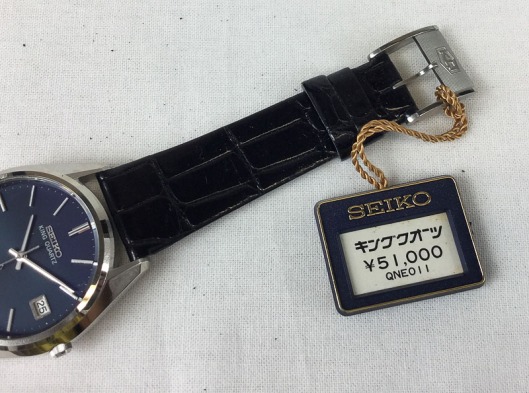
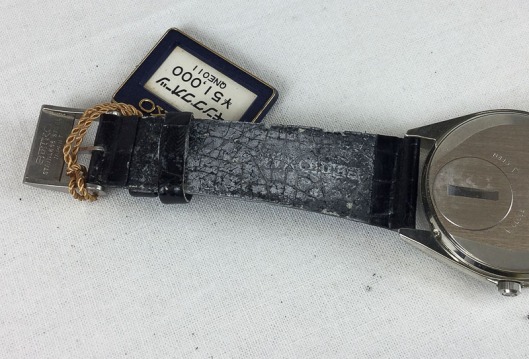
Were you not tempted to strip, clean and oil? Surely the original oils would be 40 years old by now and a little dry.
Absolutely. I’ll get to it at some point but for the moment I wanted to focus on the watch without the distractions of all the usual movement servicing stuff. I bought this on the spur of the moment and was intrigued by the notion of something so nice having been available so fleetingly and now largely overlooked.
Hi Martin,
Any chance you would consider selling the King Quartz? It’s from my birth year and I have also loved them, keeping an eye out for a good one. I have a modern GS now but if you would consider selling that KS please let me know.
Thanks and best regards,
Steve Mclachlan.
Beautiful watches. i was given one by my father-in-law.However the winder somehow fell off. It was sent to Japan but returned by Seiko with their note saying they couldn’t help. It has lain dormant some years and now i want to revive it,starting with a new (external) winder.
Any guidance would be much appreciated. 5856-5020
Richard
It should still be possible to find a crown and stem for your watch but that may need a little detective work, combing places such as watch materials houses, parts sellers on eBay and Yahoo Japan. Depending on where you live, there should be watchmakers with Seikos expertise who could help you too. Are you US, UK or somewhere else?
4803,4821,4822,4823,4840,4842,4843 (354680,354-680) any of them stems would fit
SEIKO SA 1W73HA00 5856-5020 IS THE CORRECT CRYSTAL
Hello, any idea what crystal to use for replacement for this model?
According to the Jules Borel database, the correct crystal part number is 300W88GA.
Any idea what part is the seal for the battery hatch?
Afraid not – sorry. My quartz casing parts guide is from 1981 and doesn’t list this model and Jules Borel has no info. other than the crystal part number.
Great work Martin, I really enjoy reading up and looking at the great pictures and write-up you post here on these rare and beautiful watches. I have an opportunity to pick up the white dial version of 4822-8000 but unfortunately it is not running. But the case and dial looks fantastic and I would like to restore it. Any idea where to get a 4822A movement or it is possible to replace with a modern Seiko quartz? I am definitely amateur at watch restoration, so far only worked on regulating 7S26 and replacing a crystal.
The only suggestion I would make for whole movements would be to try Yahoo Japan auctions. You may even be able to find a complete watch for less than the cost of sourcing a movement. Very often, a service will bring a non-functioning quartz movement back to life, as long as none of the electronic components is dead. And I’m afraid I don’t know the dimensions nor stem height and so would not be able to suggest a modern drop in replacement. My guess is that there are none, but that is just a guess. Good luck!